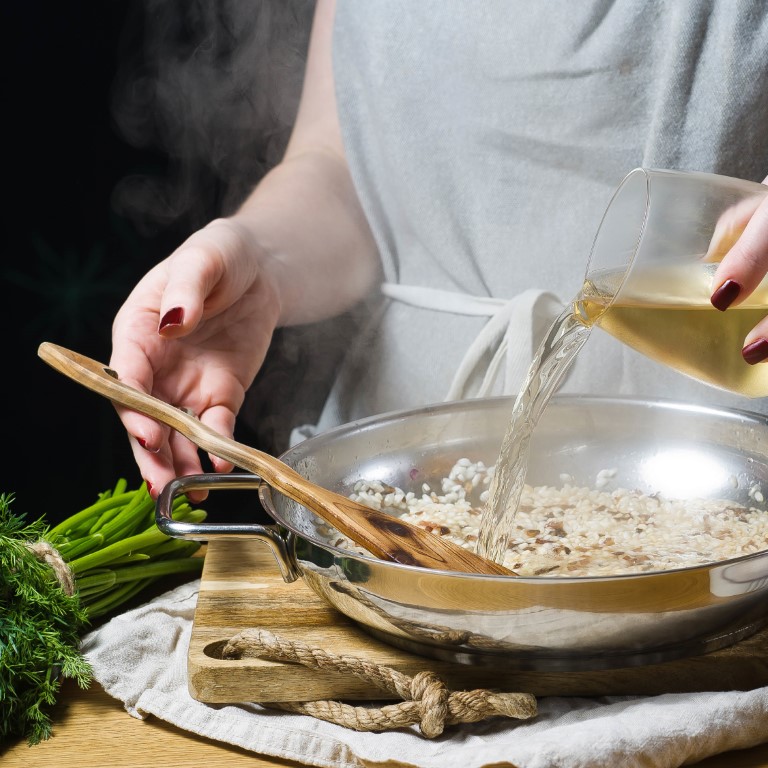Craft & Cork >> Winemaking

Beyond the Glass: A Short Guide to Cooking and Baking with Wine
You’re reading this because of your love of wine, but the beauty of this most beloved liquid is that its versatility extends beyond the glass. In the kitchen, wine has long been used to elevate the ordinary to extraordinary. It’s a transformative ingredient, which can bring depth, complexity, and elegance to both savoury dishes and sweet treats. Whether you’re simmering a rich sauce, braising meat, or baking a decadent dessert, a bit of wine can enhance your recipe in ways both subtle and profound. Plus, using wine in cooking and baking is a fantastic way to make the most of already opened bottles, ensuring that every drop is put to good use.
Savoury Cooking with Wine
1. Deglazing and Sauces
Wine is a classic choice for deglazing a pan, a technique that involves adding liquid to a hot pan after searing meat to lift the caramelized bits off the bottom, creating the base for a sauce. Both red and white wines work beautifully for this, with the type of wine chosen dependent on the dish. For example:
- Red Wine: It’s perfect for rich, hearty dishes like beef or lamb. Opt for a full-bodied red, such as Cabernet Sauvignon or Merlot, to create a robust sauce. These wines add depth with flavors of dark fruit, spices, and sometimes a hint of oak, which complements the savory notes of the meat.
- White Wine: They’re ideal for lighter proteins like chicken, pork, or fish. A dry white wine, such as Sauvignon Blanc or Chardonnay, adds brightness and acidity to sauces, lifting the flavours of the dish. Chardonnay, especially when oaked, can also add a slight creaminess to your sauce which is lovely, for example, when prepping seafood pasta.
2. Braising and Stews
Braising is a slow-cooking method that benefits greatly from the addition of wine. The alcohol in wine helps to break down the fibres in meat, making it tender and flavourful, while the acidity brings balance to rich, fatty cuts.
- Red Wine: Use a medium to full-bodied red wine, such as Zinfandel or Syrah, for braising beef short ribs, lamb shanks, or oxtails. These wines impart deep, robust flavors that enhance the richness of the meat.
- White Wine: A dry white like Pinot Grigio or a slightly fuller-bodied Chardonnay works well for braising chicken, pork, or vegetables. The wine’s acidity helps to tenderize the meat while adding a subtle flavour that complements lighter dishes.
3. Marinades and Reductions
Wine is also a great ingredient in marinades, where it not only adds flavour but also helps to tenderize proteins. A wine-based marinade can include herbs, garlic, and spices, with the wine providing the necessary acidity to penetrate the meat.
- Red Wine: For a marinade, opt for a fruity red like Grenache or a versatile Pinot Noir, which can be used for everything from steak to game meats.
- White Wine: A crisp, acidic white like Riesling or Sauvignon Blanc is perfect for marinating chicken, seafood, or pork, infusing the meat with fresh, zesty flavors.
Wine reductions are another fantastic way to concentrate the flavors of wine into a sauce or glaze. Simply simmer wine with aromatics like shallots, garlic, and herbs until it reduces by half or more, creating a rich, flavourful condiment.
Baking with Wine: A Sweet Idea
Wine isn’t just for savoury dishes – it can also add complexity and moisture to baked goods, making your desserts a truly unique taste experience.
1. Wine-Infused Cakes and Pastries
Using wine in cake batters or pastry doughs can add a subtle, sophisticated flavour. For example:
- Red Wine: A red wine, such as Port or a fruity Zinfandel, can be used in chocolate cakes, brownies, or even in a red wine reduction sauce drizzled over desserts. The deep, fruity notes of the wine enhance the richness of chocolate, adding a layer of complexity.
- White Wine: A dry or sweet white wine like Moscato or a floral Gewürztraminer can be incorporated into cake batters, particularly for fruit-based cakes or light, citrus-flavoured pastries. The wine’s natural sweetness and acidity balance the sugar and fat in baked goods, creating delicious flavour harmony.
2. Poaching Fruit in Wine
Poaching fruit in wine is a simple yet elegant way to create desserts that are both flavourful and Instagrammable! Pears, apples, or peaches poached in red or white wine take on the colour and flavour of the wine, resulting in a dish that’s as beautiful as it is delicious.
- Red Wine: Use a light-bodied red like Pinot Noir for poaching pears or apples, infusing them with the wine’s berry notes and creating a rich syrup as the poaching liquid reduces.
- White Wine: A sweet white wine like Riesling or a sparkling wine is ideal for poaching peaches or apricots. The method adds a floral sweetness to enhance the fruit’s natural flavour.
Maximizing Leftover Wine
One of the best things about cooking and baking with wine is that it’s a perfect way to use up leftovers. Once a bottle has been opened, wine begins to oxidize, which can dull its flavour and aromatics over time. Rather than letting that wine go to waste, incorporate it into your cooking. Opened bottles of wine can last in the fridge for several days to a week, giving you plenty of time to experiment in the kitchen.
From deglazing pans to creating decadent desserts, the versatility of wine in the kitchen is unparalleled. And with the added benefit of using up leftovers, you can feel good about not letting any of that precious bottle go to waste. So next time you have an open and unfinished bottle, consider how you might incorporate it into your menu. Your taste buds will thank you.


Recent Comments